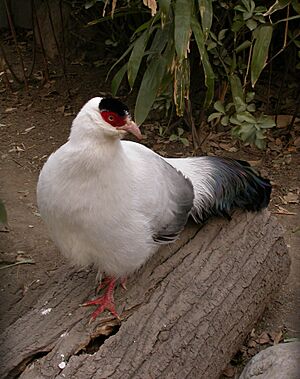White eared pheasant facts for kids
Quick facts for kids White eared pheasant |
|
|---|---|
 |
|
| Conservation status | |
| Scientific classification | |
| Genus: |
Crossoptilon
|
| Species: |
crossoptilon
|
The white eared pheasant (Crossoptilon crossoptilon) is a special type of bird. It's also called Dolan’s eared pheasant or Bee's pheasant. This bird gets its name because it's mostly white and has fluffy feathers near its ears. These feathers look like ear tufts, which is why it's called an "eared pheasant."
People in the Himalaya mountains call it bo shagga, which means "snow fowl." This bird loves to be with others and lives in big groups. They look for food in high mountain meadows, often near or above the snowline. You can find them all year round in these snowy places. White eared pheasants live in China, including areas like Qinghai, Sichuan, Yunnan, and Tibet. They often live in mixed forests and sometimes near Buddhist monasteries.
Contents
How White Eared Pheasants Fly
White eared pheasants fly more often than their close relatives. These include the brown eared pheasant (C. mantchuricum) and the blue eared pheasant (C. auritum). All three types of pheasants can hover or glide over deep snow. They use their big, wide tails to help them do this.
When moving across deep snow, eared pheasants flutter their wings close to the ground. They use their strong tail feathers to support their weight. In the past, hunters thought these pheasants were not good at flying. This was because hunters used dogs to make the birds fly up from the ground.
Eared pheasants do not fly away when animals like wolves or foxes hunt them. Instead, they have learned other ways to escape danger without flying. They can fly for short distances, a few hundred yards at a time. This is very helpful during snowy seasons. This ability to fly over long distances is like ptarmigans and sage grouse. These birds also live in snowy areas and fly to find food in winter.
What Do White Eared Pheasants Eat?
The white eared pheasant looks for food in high mountain meadows. They often search for tubers and roots. Sometimes, they forage alongside yaks or other animals with hooves.
In winter, when food is harder to find, they eat different things. Their diet includes pine needles, juniper berries, and wolf berries. They also eat dried seed pods from iris, lily, and allium plants. During very bad winter storms that can last for weeks, they can survive on pine sap. They might also eat dung (poop) from deer, rabbits, and yaks if they are very hungry.
Different Types of White Eared Pheasants
All white eared pheasants look very similar. However, their behaviors and genes show there is still much to learn about them. Scientists study how they act and how they are related.
The Szechuan white eared pheasant (C. c. crossoptilon) is one type. It is a bird that lives in the Sichuan region of China. This bird lives at high altitudes on rocky areas. In winter, it may move down to old-growth forests. Its wings are dark-grey or violet.
This pheasant is mostly white, including its ear tufts. But it is not as white as its relatives, the Tibetan white eared pheasant (C. c. drouyni) and the Yunnan white eared pheasant (C. c. lichiangnse). It has black tail feathers and black tips on its wings. There is also a black patch on top of its head. The main wing feathers can be dark grey to brown. The skin on its face, not covered by feathers, is red.
White Eared Pheasant Reproduction
Szechuan white eared pheasants start to mate when they are two years old. Their breeding season begins around the end of April and lasts until June. These pheasants usually lay four to seven eggs in one clutch. The eggs hatch after about 24 to 25 days of incubation.
Male and female Szechuan white eared pheasants look very similar. However, the males are quite a bit bigger than the females. Males can grow to be about 86–96 centimeters (34–38 inches) long. Females weigh between 1400–2050 grams (3.1–4.5 pounds). Males are heavier, weighing 2350–2750 grams (5.2–6.1 pounds).
Protecting White Eared Pheasants
The Szechuan white eared pheasant is now considered a near-threatened species. This means their numbers are getting low. People building more homes and farms in China has reduced the areas where these pheasants live. Also, hunting these pheasants for food has greatly reduced how many there are.
Today, it is estimated that only 6,700 to 33,000 of these birds live in the wild. Luckily, the local Tibetan Buddhist culture helps protect C. crossoptilon in their area.
See also


